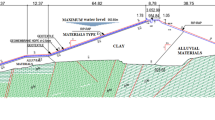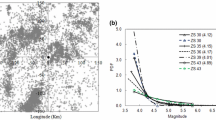Abstract
This paper examines hydrodynamic pressure diagrams due to earthquakes acting on distinct configurations of the upstream face of a dam, considering the reservoir length and different bathymetries of the reservoir bottom. Two suitable mathematical models are used to obtain the dynamic pressure on the dam, and the reservoir free surface oscillation. Conceptual mathematical models are proposed to study the impact of a landslide triggered by an earthquake, and its progress into the reservoir. The waves formed when a landslide advances into the reservoir are tested with the help of laboratory results. These waves and their propagation in the reservoir are studied using experimental data and numerical results, including wave-type analyses based on dimensionless parameters. Two distinct 1DH and 2DV numerical models based on different mathematical formulations are tested. A discussion of physical and numerical results is detailed in a general risk context and uncertainty associated with the input data in a deterministic model. Numerical simulations are performed for the upper and lower limits of the sliding mass velocity diagram which is obtained as a result of the intrinsic uncertainty of the stochastic nature of the friction angle. Finally, the findings are discussed and some conclusions drawn.




















Similar content being viewed by others
Abbreviations
- A :
-
Slide mass section
- a c :
-
Wave crest amplitude
- a M :
-
Maximum wave crest amplitude
- \( \ddot{a}_{g} \) :
-
Horizontal acceleration of the ground motion
- A p , A s :
-
Coefficients for progressive and standing waves
- b :
-
Slide width
- c :
-
Velocity of sound in water (c ≈ 1,438 ms−1)
- c c :
-
Wave velocity
- C i :
-
Constant (0.0, 0.5 or 1.0)
- C d :
-
Drag coefficient for the slide
- C D = 0.085:
-
(constant)
- \( C_{p} \left( {x,z} \right) = {{\bar{p}\left( {x,z} \right)} \mathord{\left/ {\vphantom {{\bar{p}\left( {x,z} \right)} {p_{h} \left( H \right)}}} \right. \kern-\nulldelimiterspace} {p_{h} \left( H \right)}} \) :
-
Normalized pressure coefficient
- Cε1=1.42, Cε2 = 1.68:
-
(constants)
- F = F(x,z,t):
-
VOF-function
- \( F = {{v_{s} } \mathord{\left/ {\vphantom {{v_{s} } {\sqrt {gh_{0} } }}} \right. \kern-\nulldelimiterspace} {\sqrt {gh_{0} } }} \) :
-
Froude number
- g :
-
Acceleration due to gravity
- \( \vec{g} = g\left( {g_{x} ,g_{z} } \right) \) :
-
Body force
- h :
-
Total water depth
- H :
-
Initial water level; reservoir water depth close to the dam; height
- H p :
-
Height with a different slope
- h 0 :
-
Initial reservoir water level; still water depth
- i, j:
-
Indexes; point and element
- k :
-
Wave number; turbulent kinetic energy
- k p , k s :
-
Wave numbers for progressive and standing waves
- L :
-
Length; weave length
- m s :
-
Sliding mass
- M :
-
Mass of the sliding block
- M w :
-
Submerged mass
- n :
-
Normal to an element
- p :
-
Progressive wave index
- p = p(x, z, t):
-
Mean pressure
- \( p = \bar{p}\left( {x,z,w} \right)e^{iwt} \) :
-
Hydrodynamic pressure
- P :
-
Production of turbulent kinetic energy
- \( \bar{p} = \bar{p}\left( {x,z,w} \right) \) :
-
Frequency response function for hydrodynamic pressure
- \( p_{h} \left( z \right) = \rho g z \) :
-
Hydrostatic pressure
- p t (x, z):
-
Total pressure on the upstream face of a dam
- r :
-
Radius vector
- R :
-
Rate-of-strain
- s :
-
Slide thickness; standing wave index
- S=s/h0:
-
Dimensionless slide thickness, boundary
- S j :
-
Length of element j
- t :
-
Time
- T :
-
Thickness
- t s :
-
Sliding time
- \( \bar{u} \) :
-
Horizontal mean velocity
- \( \vec{u} = \left[ {u \, \left( {x,z,t} \right), \, w \, \left( {x,z,t} \right)} \right] \) :
-
Mean velocity vector
- \( V = {{V_{s} } \mathord{\left/ {\vphantom {{V_{s} } {\left( {bh_{0}^{2} } \right)}}} \right. \kern-\nulldelimiterspace} {\left( {bh_{0}^{2} } \right)}} \) :
-
Dimensionless slide volume
- v s :
-
Sliding mass velocity
- v sm :
-
Slide velocity when the mass centre reaches the water surface
- V s :
-
Slide volume
- w :
-
Frequency of the horizontal ground motion; angular frequency
- W :
-
Width
- x :
-
Space
- x, z:
-
Rectangular coordinates
- α:
-
Bank slope; slide impact angle
- \( \ddot{a}_{g} \) :
-
Acceleration of the movement
- β:
-
Angle between an element situated at the reservoir bottom and the x-axis
- ∆z :
-
Height of the mass centre positions
- \( \varepsilon = \varepsilon \left( {x,z,t} \right) \) :
-
Dissipation rate
- \( \phi \) :
-
Friction angle; velocity potential
- \( \varphi = \left( {{6 \mathord{\left/ {\vphantom {6 7}} \right. \kern-\nulldelimiterspace} 7}} \right) \, \alpha \),:
-
With α being the slide impact angle
- \( \eta = h - H + \xi \) :
-
Surface elevation
- \( \eta_{por} \approx 0.40 \) :
-
Porosity
- v :
-
Kinematic viscosity
- v T :
-
Eddy viscosity
- θ:
-
Angle between the x-axis and the normal to an element situated at the upstream face of a dam; porosity function; parameter
- \( \rho = \rho_{w} \) :
-
Density of water
- \( \rho_{s} \) :
-
Density of sliding mass
- \( \sigma_{k} = 1.0, \sigma_{\varepsilon} = 1.3 \) :
-
(constants)
- \( \varsigma_{0} \) :
-
Amplitude of the harmonic motion
- \( \tau \left( \xi \right) \) :
-
Bottom shear stress
- \( \xi \) :
-
Bed elevation
References
Almeida AB, Viseu T (1997) Dams and valleys safety. A present and future challenge. In: Almeida AB, Viseu T (eds) Dams and safety management in downstream valleys. AA Balkema, Rotterdam, pp 03–25
Almeida AB, Ramos CM, Santos MA, Viseu T (2003) Dam break flood risk management in Portugal (book). LNEC, Lisbon. ISBN 972-49-1979-X
Antunes do Carmo JS (2004) Modelling in fluvial hydraulics and environment (book). Ed. Coimbra University Press, Portugal. ISBN 972-8704-28-3 (in Portuguese)
Antunes do Carmo JS (2010) Wave-current interactions over bottom with appreciable variations both in space and time. J Adv Eng Softw 41(2):295–305
Antunes do Carmo JS, Seabra Santos FJ (1996) On breaking waves and wave current interaction in shallow water. A 2DH finite element model. Int J Numer Methods Fluids 22:429–444
Avilés J, Sánchez-Sesma FJ (1986) Hydrodynamic pressure on dams with nonvertical upstream face. J Eng Mech 112(10):1054–1061
Bayraktar A, Türker T, Akköse M, Ates S (2010) The effect of reservoir length on seismic performance of gravity dams to near- and far-fault ground motions. Nat Hazards 52:257–275. doi:10.1007/s11069-009-9368-1
Carvalho RF (2002) Hydrodynamic actions on hydraulic structures: Computational modelling of the hydraulic jump. Ph.D thesis, University of Coimbra, Portugal (in Portuguese)
Carvalho RF, Antunes do Carmo JS (2006) Numerical and experimental modelling of the generation and propagation of waves caused by landslides into reservoirs and their effects on dams. In: Proceedings of the River Flow 2006 conference, Lisbon (LNEC), 06-08 September. Taylor and Francis/BALKEMA, vol 1, pp 483–492. ISBN 0-415-40810-5
Carvalho RF, Antunes do Carmo JS (2007) Landslides into reservoirs and their impacts on banks. J Environ Fluid Mech, Springer Netherlands, 7(6):481–493
Dean RG, Dalrymple RA (1984) Water wave mechanics for engineers and scientists, Prentice-Hall, Inc. ISBN 0-13-946038-2
Fritz HM, Hager WH, Minor H-E (2004) Near field characteristics of landslide generated impulse waves. J Waterway Port Coastal Ocean Eng 130(6):287–302
Gogoi I, Maity D (2008) A novel procedure for determination of hydrodynamic pressure along upstream face of dams due to earthquakes. In: The 14th World Conference on Earthquake Engineering, October 12–17, 2008, Beijing, China
Hanna YG, Humar JL (1982) Boundary element analysis of fluid domain. J Eng Mech Div 108(EM2):436–449
Havenith H-B, Bourdeau C (2010) Earthquake-induced landslide hazards in mountain regions: a review of case histories from central Asia. Geologica Belgica 13/3:137–152
Heller V (2008) Landslide generated impulse waves: Prediction of near field characteristics, PhD thesis. Mitteilungen 204, Versuchsanstalt fur Wasserbau, Hydrologie und Glaziologie (VAW), ETH Zurich. ISSN 0374-0056
Kouli M, Loupasakis C, Soupios P, Vallianatos F (2009) Landslide hazard zonation in high risk areas of Rethymno Prefecture, Crete Island, Greece. Nat Hazards 52:599–621. doi:10.1007/s11069-009-9403-2
Lynett P, Liu PLF (2005) A numerical study of the run-up generated by three-dimensional landslides. J Geophys Research-Oceans 110(C3):Art. No. C03006 MAR 8 2005
Schuster RL, Highland LM (2004) Impact of landslides and innovative landslide-mitigation measures on the natural environment, International Conference on Slope Engineering, Hong Kong, China, December 8–10, Proceedings 29
Seabra-Santos FJ (1995) Dam break events—accidents and wave propagation. In: Marques JAS, Lima JLMP (eds) Hydroelectric power plants (book), University of Coimbra, pp 229–259. ISSN 0870-5011
Singh VP (1996) Dam break modelling technology. Kluwer, Dordrecht
Yakhot V, Orszag SA (1986) Renormalization group analysis of turbulence. I. Basic Theory J Sci Comput 1(1):3–51
Yakhot V, Smith LM (1992) The renormalization group, the ε-expansion and derivation of turbulence models. J Sci Comput 7(1):35–61
Zee C-H, Zee R (2006) Earthquake hydrodynamic pressure on dams. J Hydraul Eng 132(11):1128–1133
Acknowledgments
The authors wish to acknowledge the Portuguese Foundation for Science and Technology for support under the project POCTI/ECM/2688/2003.
Author information
Authors and Affiliations
Corresponding author
Rights and permissions
About this article
Cite this article
Antunes do Carmo, J.S., de Carvalho, R.F. Large dam-reservoir systems: guidelines and tools to estimate loads resulting from natural hazards. Nat Hazards 59, 75–106 (2011). https://doi.org/10.1007/s11069-011-9740-9
Received:
Accepted:
Published:
Issue Date:
DOI: https://doi.org/10.1007/s11069-011-9740-9




